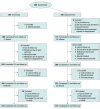Overminus Lens Therapy for Children 3 to 10 Years of Age With Intermittent Exotropia: A Randomized Clinical Trial
- PMID: 33662112
- PMCID: PMC7934080
- DOI: 10.1001/jamaophthalmol.2021.0082
Overminus Lens Therapy for Children 3 to 10 Years of Age With Intermittent Exotropia: A Randomized Clinical Trial
Abstract
Importance: This is the first large-scale randomized clinical trial evaluating the effectiveness and safety of overminus spectacle therapy for treatment of intermittent exotropia (IXT).
Objective: To evaluate the effectiveness of overminus spectacles to improve distance IXT control.
Design, setting, and participants: This randomized clinical trial conducted at 56 clinical sites between January 2017 and January 2019 associated with the Pediatric Eye Disease Investigator Group enrolled 386 children aged 3 to 10 years with IXT, a mean distance control score of 2 or worse, and a refractive error between 1.00 and -6.00 diopters (D). Data analysis was performed from February to December 2020.
Interventions: Participants were randomly assigned to overminus spectacle therapy (-2.50 D for 12 months, then -1.25 D for 3 months, followed by nonoverminus spectacles for 3 months) or to nonoverminus spectacle use.
Main outcomes and measures: Primary and secondary outcomes were the mean distance IXT control scores of participants examined after 12 months of treatment (primary outcome) and at 18 months (3 months after treatment ended) assessed by an examiner masked to treatment group. Change in refractive error from baseline to 12 months was compared between groups. Analyses were performed using the intention-to-treat population.
Results: The mean (SD) age of 196 participants randomized to overminus therapy and 190 participants randomized to nonoverminus treatment was 6.3 (2.1) years, and 226 (59%) were female. Mean distance control at 12 months was better in participants treated with overminus spectacles than with nonoverminus spectacles (1.8 vs 2.8 points; adjusted difference, -0.8; 95% CI, -1.0 to -0.5; P < .001). At 18 months, there was little or no difference in mean distance control between overminus and nonoverminus groups (2.4 vs 2.7 points; adjusted difference, -0.2; 95% CI, -0.5 to 0.04; P = .09). Myopic shift from baseline to 12 months was greater in the overminus than the nonoverminus group (-0.42 D vs -0.04 D; adjusted difference, -0.37 D; 95% CI, -0.49 to -0.26 D; P < .001), with 33 of 189 children (17%) in the overminus group vs 2 of 169 (1%) in the nonoverminus group having a shift higher than 1.00 D.
Conclusions and relevance: Children 3 to 10 years of age had improved distance exotropia control when assessed wearing overminus spectacles after 12 months of overminus treatment; however, this treatment was associated with increased myopic shift. The beneficial effect of overminus lens therapy on distance exotropia control was not maintained after treatment was tapered off for 3 months and children were examined 3 months later.
Trial registration: ClinicalTrials.gov Identifier: NCT02807350.
Conflict of interest statement
Figures

Comment in
-
Overminus Lens Therapy for Children With Intermittent Exotropia.JAMA Ophthalmol. 2021 Apr 1;139(4):476-477. doi: 10.1001/jamaophthalmol.2021.0081. JAMA Ophthalmol. 2021. PMID: 33662095 No abstract available.
-
Broader Implications of Overminus Lens Therapy in Relation to Myopia Management.JAMA Ophthalmol. 2022 Jan 1;140(1):97-98. doi: 10.1001/jamaophthalmol.2021.4854. JAMA Ophthalmol. 2022. PMID: 34792547 No abstract available.
-
Broader Implications of Overminus Lens Therapy in Relation to Myopia Management-Reply.JAMA Ophthalmol. 2022 Jan 1;140(1):98. doi: 10.1001/jamaophthalmol.2021.4857. JAMA Ophthalmol. 2022. PMID: 34792550 No abstract available.
References
-
- Romano PE, Wilson MF. Survey of current management of intermittent exotropia in the USA and Canada. In: Campos EC, ed. Strabismus and Ocular Motility Disorders. Macmillan Press; 1990:391-396. doi:10.1007/978-1-349-11188-6_55 - DOI
-
- Donaldson PJ, Kemp EG. An initial study of the treatment of intermittent exotropia by minus overcorrection. Br Orthopt J. 1991;48:41-43.
-
- Reynolds JD, Wackerhagen M, Olitsky SE. Overminus lens therapy for intermittent exotropia. Am Orthopt J. 1994;44:86-91. doi:10.1080/0065955X.1994.11982018 - DOI
Publication types
MeSH terms
Associated data
Grants and funding
LinkOut - more resources
Full Text Sources
Other Literature Sources
Medical

